High-rise buildings offer sweeping lakefront views from corner units; amenities including gyms and swimming pools, even sprawling party rooms that span the 20,000-square-foot top floors with rooftop decks. Sounds pretty enticing, right? Maybe if you’re in the market to buy a unit in the building. What if you’re now assigning or are assigned as a rapid intervention team (RIT) that may be responsible for locating a missing firefighter in one of these areas? Are you prepared? Is your assigned team prepared? Where do you even begin?
Selection and Planning
In the fire service, although preparation is undoubtedly the key to success, how many of us can say that we, our crew, and our department as a whole are prepared to handle a given incident at any given time? Before you answer, think about not only the resources that you have available but the physical and mental health of all the aforementioned. If you already answered, would your answer change?
RELATED FIREFIGHTER TRAINING
High-Rise RIT Saves Trapped Firefighters
The Ups and Downs of Understanding High-Rise Stairwells
Fires in High-Rise Fire-Resistive Multiple Dwellings
High-rise buildings present some unique characteristics that you need to address prior to arriving on scene. Many factors can contribute to why a RIT must be deployed. The U.S. Fire Administration highlighted that inadequate development of standard operating procedures (SOPs) preincident along with lack of adherence to established SOPs was a significant contributor to preventable injuries and deaths of firefighters.1 When developing SOPs, consider and communicate with the department and mutual-aid partners as to which responding fire companies will be designated as RITs at a high-rise during the preplanning phase. This eliminates confusion and decreases reflex time if they are needed early in the incident. These SOPs should outline what is expected of RITs so clear assignments are in place whenever you need to promptly deploy them.
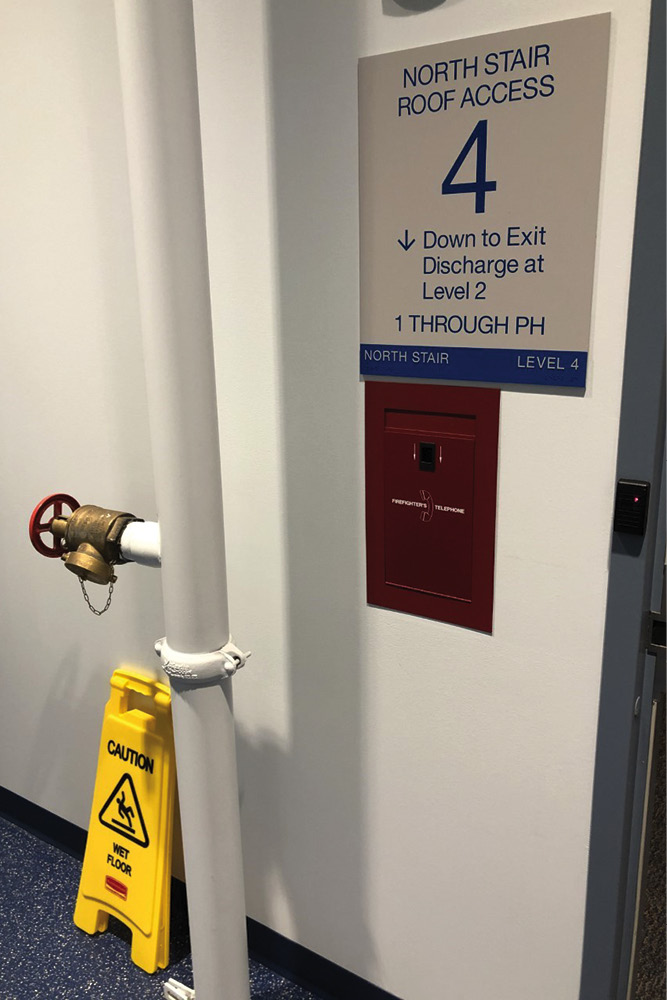
(1) Whether you are a RIT member or staging a RIT, note the stairwell phone’s location; it offers an alternative means to communicate with the IC in the lobby. (Photos by author.)

(2) Size-up includes knowing where key items (e.g., the AED, the building floor map, an alternative means of communication) are if you need them emergently.
Regarding RITs at high-rise responses, command must consider the structure’s size, its occupancy, and where companies will be working. A high-rise building is akin to a city block turned vertically. According to statistics from Donald Abbott’s Project Mayday, on average, it takes
- 79 seconds to transmit and acknowledge a Mayday (36 percent of such transmissions were missed on the first call),2
- 2.5 minutes for a RIT to get in “ready” state,
- 3.03 minutes from Mayday to RIT entry,
- 5.82 minutes to contact a down firefighter,
- 12.33 minutes for each RIT inside,
- approximately 21 minutes overall to rescue a firefighter, and
- 12 firefighters to rescue one.
This is somewhat compelling when you consider that most team deployments were in nonhigh-rise (less than seven-floor) buildings2 and the average residential home size in the United States is 1,625 square feet.3
Factor in the following when preparing to assign or act as a RIT for a high-rise incident. Some commercial high-rises may encompass a space of 20,000 square feet per floor containing numerous hazards such as cubicles and drop ceilings. Elements such as these can present complications for RITs. Recognize and factor in the need to overcome such obstacles in preplanning and during SOP development when formulating appropriate staging areas for RITs in anticipation of deployment.
Companies will be searching all stairwells (at minimum, two), walking up and down, and the floor above the fire. Some incident commanders (ICs) at a residential structure employ “proactive RIT” to help “soften” the building when a Mayday is called. In the proactive RIT tactic, multiple RITs are staged at various intervals throughout the building. A rapid response is not possible if the RIT has to ascend multiple floors to find a down firefighter. In a larger building with more than two stairwells, strategically place RITs to allow them to promptly deploy from a variety of angles to access any areas where companies are working, particularly the most hazardous areas.
Selecting the traditional RIT emphasizes bringing the proper tools for rescue. Besides a RIT dedicated to rescue, at a minimum, deploy a second advanced life support (ALS) RIT to provide prompt medical attention when the down firefighter is located and removed. The ALS RIT must not be involved in any firefighter removal but be ready to provide treatment at the point of removal because of the long times that it takes to remove a firefighter from the immediately dangerous to life or health (IDLH) atmosphere, then down to the lobby.
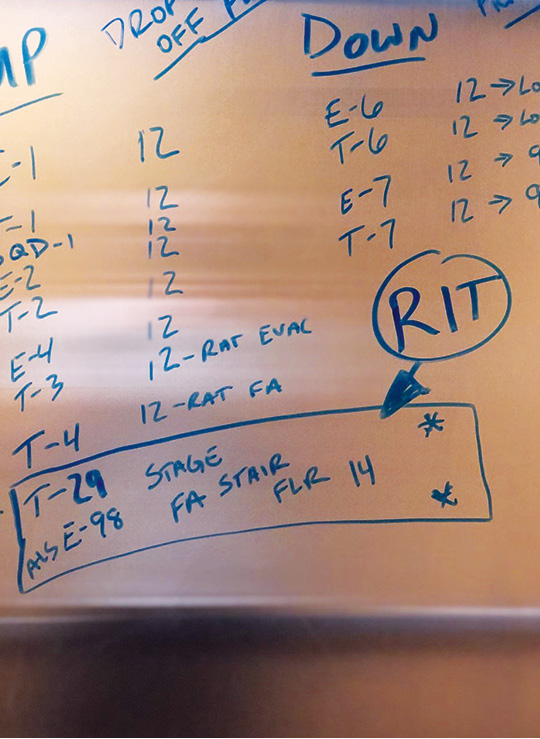
(3) The member transporting companies in the elevator should note the location of RITs if they are needed but can’t be reached by radio. “FA” indicates the fire attack stairwell.
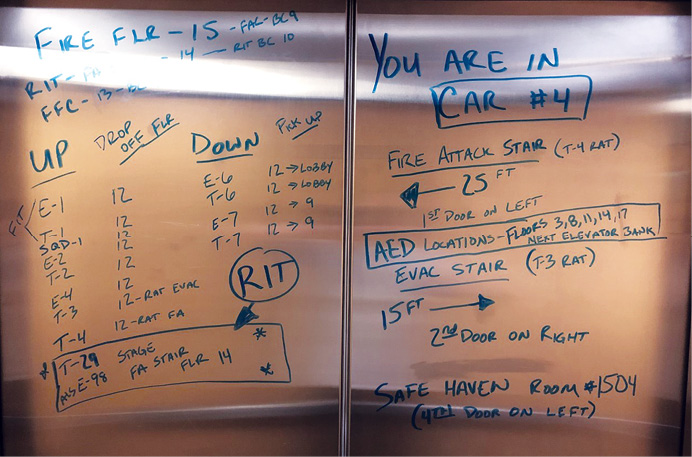
(4) The member operating the elevator should note important items such as stairwell locations and designations (right door), where important items like AEDs or safe havens (right door) are located, where the RITs are staging, and where companies were taken or their known assignment by that particular elevator to maintain accountability.
Whereas the rescue RIT is equipped with proper rescue tools, equip the ALS RIT with all of its emergency medical equipment, conveyance devices (e.g., rescue stretcher, stair chair, multihandled device to enable use of multiple members for carrying), and a defibrillator. If the down firefighter has suffered a cardiac event, medical care and cardiopulmonary resuscitation (CPR) must be started immediately; not in the lobby! Per the American Heart Association, one minute without CPR decreases the chance of survival by 10 percent.4 Consider our removal times for a residential building of approximately 1,625 square feet vs. that of a commercial high-rise of around 20,000 square feet per floor. If only one ALS RIT is in one stairwell remote from where the down firefighter has been removed or is located, can we honestly say, “We’re there when you need us”? Hence, strongly consider tactical placement of RITs in multiple locations within multiple stairwells and in the lobby.
When making the appropriate RIT selection for a high-rise as an IC, think about the following questions:
- Is the RIT response part of the initial response, or is it activated when a fire is confirmed and the alarm is upgraded?
- Is the RIT physically fit? If not, you are already behind the eight ball.
- What is the reflex time to make it up to the fire floor with the essential equipment?
- Does this building have more than two stairwells? If so, where can you strategically place RITs to effectively receive a Mayday communication and provide prompt removal and medical care? A Mayday involving a member who is searching stairwells has an increased probability because of the increased physical demand of ascending multiple floors in full gear.
- If communications are inadequate, can the RIT be staged on a floor with a stairwell phone or a two-way communication system? Consider a runner to relay messages if there are issues with communications.
- Is the RIT prepared with a thermal imaging camera (TIC), elevator keys, search rope, hydraulic forcible entry hand tools, traditional forcible entry tools, and self-contained breathing apparatus (SCBA) equipment for the down firefighter?
- Where will you stage your ALS RIT ambulance? Have you informed your ALS RIT?
- Are the RITs prepared with the proper size-up information prior to their ascent?
- Are backup RITs designated or predesignated when your team is deployed? If so, where will you stage them to reduce reflex time?
- If a civilian requires immediate medical care, will you use the RIT if there is extended reflex time from the next available company?
Firefighters who had called Maydays were asked about their confidence in the RIT coming to save them; only 19 percent were confident.2 As a firefighter, company officer, or chief, training should be ongoing, focusing on a variety of scenarios where a RIT in a high-rise can and may be deployed. Operating at an incident in which a firefighter is being removed from a structure is taxing mentally and physically. When factoring in that removal straight to an ambulance is not necessarily feasible in a high-rise, compile a training scenario that includes communication difficulties, physical obstacles, and the decision to start treatment to get people to start thinking outside the box.
Size-Up and Staging
Sizing up a high-rise building for a RIT should focus on a variety of areas. Begin size-up en route by listening to the radio to hear the first-arriving companies’ building size-up construction report and decisions that have been made. You should know where the biggest hazard is, where all companies are working, and the easiest routes to access those members in a Mayday. A thorough size-up will help not only in making tactical decisions to mitigate the fire but also in making tactical decisions for strategically staging your RITs.
For example, consider the 1991 One Meridian Plaza fire in Philadelphia, Pennsylvania, which took the lives of three firefighters. The 38-story commercial high-rise presented multiple unforeseen obstacles early in the incident that had to be overcome to assemble search teams and move them to upper floors to rescue three firefighters.5
On arrival, confer with the IC regarding the tactical movements working companies are making. The building’s Life Safety Plan will provide you with a vast amount of building data, including floor layouts (particularly the fire floor and floor above) and the location of the following: elevators in relation to the stairwells, standpipes, stairwells, basements, and sub-basements. Knowing all of this prior to ascent is important for the RIT officers. The Life Safety Plan is usually near the front desk if not already at the lobby command post.
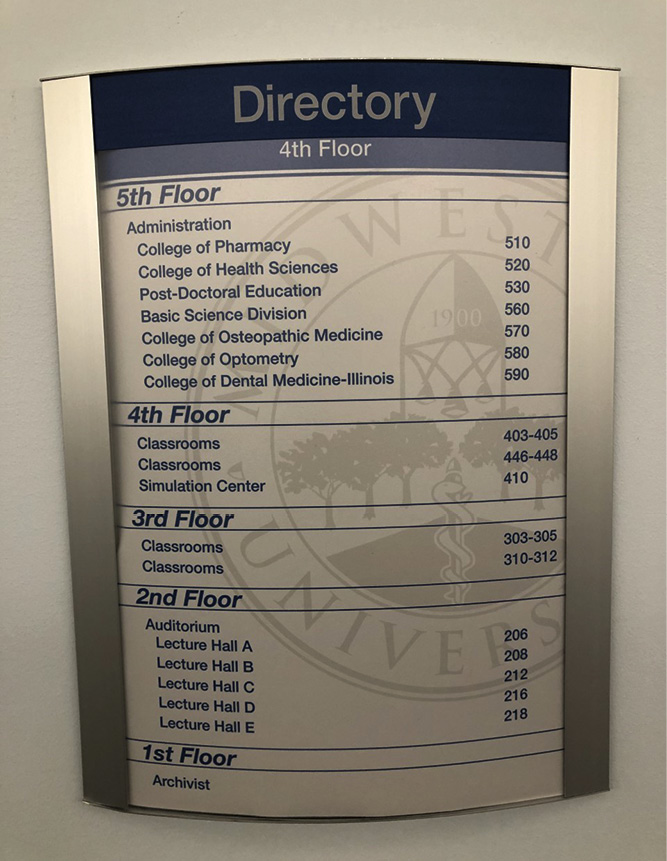
(5) In the RIT size-up, note the building’s directory or take a picture of it with a camera phone if you are unable to remove it. This can help to narrow the search for a down firefighter.

(6) Commercial buildings with long corridors and many doorways make it easy for someone to become disoriented. Consider using a search rope and viewing a floor plan if possible while in staging.

(7) The building’s evacuation plan and floor map help in determining the stairwell where most occupants may be evacuating when considering the most strategic staging for the RITs. It also prepares RITs for confusing floor layouts and the locations of alternative exits.

(8) When searching buildings with circular hallways, consider using a search rope and the TIC to guide members in their searches and to maintain accountability of search team members.
On entering the elevator to ascend, inform the firefighter elevator operator where you will stage, and have this member write this information on the elevator doors using a marker or wax pencil so all crews reporting to the fire floor know where to find the RIT if radio communication fails. Discuss with the operator how to arrange a pickup to transport a down firefighter if needed. Consider using the freight elevator if available. Freight elevators will typically stop at every floor, are larger and can better accommodate a stretcher, and have a larger weight capacity. This can be critical if providing emergency care or undressing a firefighter on the way to the RIT ambulance.
Knowing where the fire attack and evacuation stairwells are is critical if you need to report to either. Knowing which companies are searching in what stairwells, especially if using more than two stairwells for any purpose, factors into the IC’s proper RIT staging. Figuring this out after the ascent may delay passing on critical information regarding strategic RIT placement.
Stage the first RIT in a tactically advantageous position close to the fire floor and the floor above in or near the fire attack stairwell. To limit reflex time, positioning on the floor below may be a better option because the RIT will be within speaking distance if it cannot be immediately reached by radio. Keep in mind communications may be difficult or inadequate, so, if possible, consider giving the RIT a building radio or staging them near a stairwell phone if they need to contact lobby command. Although face-to-face communication is preferred, it is not always practical.
Staging a member with a radio in the stairwell or near a window may help to enhance communications so the message can then be relayed face-to-face. Consider designating a separate RIT chief (if your department does not do so already) or have an ALS RIT member standing by to provide medical care and stabilization immediately on removal of the injured firefighter. Not only can the ALS RIT member relay communications during a critical time, but he will also be able to hear critical communications regarding what is needed to begin caring for the injured firefighter. If staffing is adequate, stage the second RIT in the evacuation stairwell. If a search is required, RITs can enter from different directions to cover more area. Once removal is made in either direction, you will also be prepared to provide prompt medical care.
When teams are performing stairwell searches, consider a few things in regard to strategic tactical staging. Considering the number of floors teams will have to ascend, is it feasible or appropriate to put RITs on multiple floors above the fire to reduce reflex time should a member searching stairwells call a Mayday? If fire companies are operating on multiple channels for any reason, should a RIT be assigned a specific channel vs. scanning multiple channels? It may be necessary to monitor multiple tactical channels. If this is the case, it is imperative that all members listen to the radio at all times. Consider and designate alternate channels on which to operate before a Mayday takes place.
Another consideration is how to respond for civilians. What happens if civilians go down? Would you use a RIT to treat them medically? What would be the reflex time to remove them? If multiple RITs are staged, one team can efficiently handle this without compromising the members’ safety.
Removal of Down Firefighters
When the initial Mayday is called, this transmission takes precedence over all other communications. High-rise buildings may make it difficult to transmit from the fire floor to the lobby. Although in most protocols the IC must acknowledge the Mayday, the IC may not always hear it. Regardless of your rank, if you hear a Mayday that is not acknowledged, and then the Mayday is called again and it is still not acknowledged, answer the Mayday! Your position in the building may allow you to receive a signal or call that you can relay face-to-face to one of the RITs or to lobby command. If you cannot relay this over the radio, use the stairwell phones and two-way communication systems in Areas of Rescue Assistance.
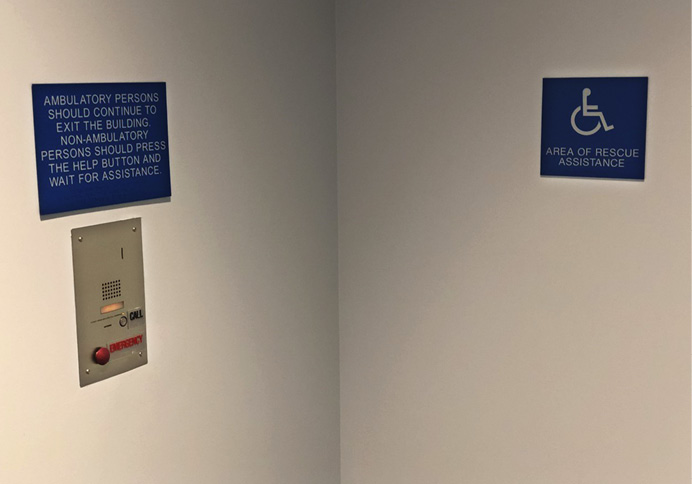
(9) Areas of Rescue Assistance for disabled building occupants have communication systems that connect to the FACP. Firefighters should be aware of this if they need to call for help or their radios are inoperable.
If you answer the unacknowledged Mayday, obtain as much information as possible, particularly the down firefighter’s location, identification, and problem (LIP). If the firefighter can provide his last known location in relation to the stairwell or any tools that may be needed to assist in his removal, relay this valuable information to the RIT. As an IC, once the RIT is deployed, activate and stage a second and even a third RIT immediately. On average, RITs use 21 percent more air than regular crews; in addition, they are ascending stairs, have increased adrenaline, and may have questionable physical fitness before reaching the area to start the rescue. Because of factors such as these or inappropriate incident size-up, one out of nine RITs end up calling a Mayday for one or more of their members.2 As an IC, the possibility of having multiple down firefighters or, in the above instance, two Maydays in different locations, you must now ask, who is going to mitigate each incident? How long will it take? If these members are both in cardiac arrest, can I start resuscitation on both when and where they are removed?
Removing a down firefighter in any scenario will require personnel and effective communication among multiple fire companies. Members not immediately involved in the rescue must understand that it is imperative they continue with their assigned task. Putting water on the fire will benefit all crews working and the down firefighter by making the environment more tenable. An effective and efficient leader will ensure completion of a thorough size-up before ascending, again in the RIT staging area, and continuously throughout the incident. Relay the size-up’s details to all members. Make members aware of any communication concerns and how to overcome them.
Delegate assignments for each member before a Mayday occurs, specifically assigning a reliable member to start CPR if needed.
The IC or another delegated firefighter should continuously reassure the firefighter needing rescue. Although he may be under severe mental stress, try to get the firefighter to slow his breathing. Try to talk the member through a plan on what can be done with what is available if he runs out of air. Things such as calming down to control breathing, finding a corner near the floor to attempt to get breathable air, or closing a door to a room can save a life but can be overlooked when under stress. Pending the situation, if the firefighter can self-place a hasty harness prior to the RIT’s arrival, it will expedite removal if the firefighter is injured and must be dragged.
Once the firefighter is found, relay where the removal will be made to the ALS RIT. This team is just like the rescue team; it should ensure it makes assignments prior to the removal. The situation drives what questions should be asked among the team but should include the following:
- Where will treatment begin (e.g., in the stairwell, the hallway, and adjacent apartment, etc.)? Start emergent treatment (e.g., cardiac arrest, splinting long bone fractures, applying oxygen, etc.) immediately, not in the lobby!
- Is there a nearby apartment unit, floor below the fire, or hallway that can allow for safe medical treatment to take place?
- How will you descend to the RIT ambulance? Stairs vs. elevator?
- Has the elevator operator been alerted to arrange a pickup, and what route will we take to get there? If removal is remote to the elevator used to ascend, using that elevator may not be practical. You will have to put another elevator in service, or the RIT will have to move the firefighter to the original elevator; this can end up being time-consuming.
After Firefighter Removal
After removing the down firefighter, the chief or commanding officers should assess the RIT members. This crew should be replaced and evaluated not only for physical exertion but for mental stability as well. Incidents that involve our own can cause a detrimental impact on the psyche of our members. Although physical exhaustion is easy to recover from after a day or two, the mental part may not be so easy.
A firefighter who is not mentally in the game can be a safety hazard not only to the crew but himself. As a company officer or chief officer, call for a formal debriefing immediately following the incident so members can decompress. Talking about the incident may help ease the minds of some, but let others know that help is out there and available 24/7 if needed. This article addresses being there for a firefighter when in need at a fire. Sometimes the help is needed for many others long after the fire is extinguished. By considering the mental health aspect of this early, we can help more than just one person as the days and shifts progress.
High-rise incidents are high-risk, low-frequency events for many fire departments nationwide. Training on tactics and conducting regular building walk-throughs will help us to prepare a general template for how we would like an incident to run. However, don’t limit training to optimal or easy scenarios. At either a department or a company level, start a dialogue on how we would safely rescue one of our own. Asking your RIT members questions during these drills regarding their tool selection, communication considerations, and treatment options for down firefighters will start people thinking.
References
1. United States Fire Administration. (April 26, 2018). “Factors that contribute to preventable firefighter deaths.” Retrieved from https://bit.ly/34N16Yu.
2. Abbott, D. (2019). “Mayday: Career, 2015-2019,” 236, 309, 334, 335, 386. Don Abbott’s Project Mayday. Retrieved February 14, 2020. https://bit.ly/2GmwHHh.
3. HomeAdvisor. (n.d.). HomeAdvisor. The United States, Ranked by Yard Size. Denver, Colorado, United States. Retrieved February 19, 2020, from https://www.homeadvisor.com/r/average-yard-size-by-state/.
4. American Heart Association. (March 2013). Fact Sheet: Every Second Counts Rural and Community to Access to Emergency Devices. Washington, DC, United States. Retrieved February 19, 2020. https://bit.ly/3jOHhEE.
5. Routley, J. G., Jennings, C., & Chubb, M. (1991). “Highrise Office Building Fire One Meridian Plaza, Philadelphia, Pennsylvania.” Department of Homeland Security, United States Fire Administration National Data Center. Retrieved from https://bit.ly/38x58qq.
GUIDO CALCAGNO has been a firefighter/paramedic with the Chicago (IL) Fire Department for 15 years. He has a master’s degree in public safety administration and is involved with high-rise operations training for the department.

